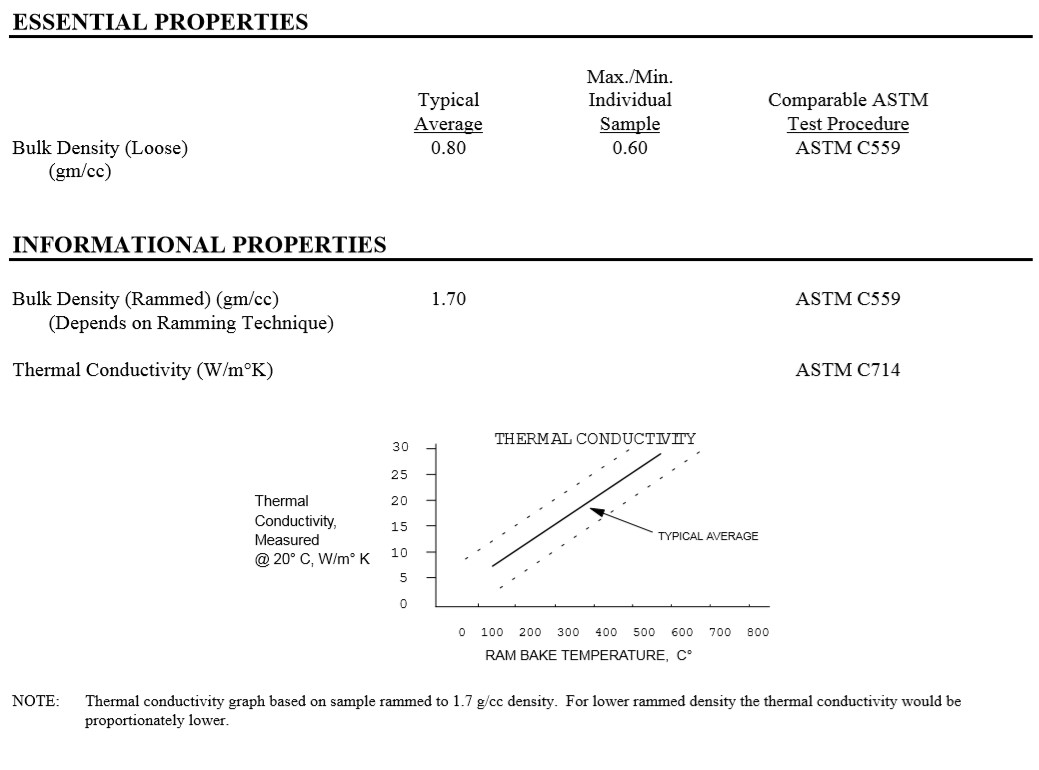UCAR EZRAM™ RP10 ramming paste is a highly thermal conductive graphitic ram, primarily used in sub-hearth, cooling pipe, and annulus between steel work and refractories. Ram must be at room temperature (20°C/70°F) before use. EZRAM™ RP10 ramming paste is available in bulk (loose) form or as pre-rammed briquettes. The pre-rammed briquettes are easily cut to shape and can be molded to fit when installed at room temperature. The bulk (loose) form is used in the same manner as other ramming materials. One advantage of the loose form is that it can be molded on site to form unique shapes as the application requires.
Both the briquettes and loose form material must be at room temperature (20° C/70° F) or higher before use.
 PACKAGING
PACKAGING
RP-10 is packaged in a corrugated fiberboard box. Each box contains approximately 22.7kg/50 pounds of loose ram or 20kg/45 pounds of briquettes.
STORAGE
Shelf life of RP-10 is two years when stored dry in original packaging at temperatures less than 35° C/95° F. Freezing temperatures are not a problem as long as ram is 20° C/70° F or above when ready for use.
INSTALLATION
Please note that this product is not suitable for and should not be used in applications PROCEDURES which are open to the atmosphere, have oxidizing atmospheres, or have molten material contact such as for tap hole plugging.
PROCEDURE FOR INSTALLATION AS ANNULUS BETWEEN STEEL SHELL/STAVES AND CARBON AND GRAPHITE REFRACTORY
1. To prevent injury from falling objects when moving boxes or pallets of ram to the work site, it is important to use proper rigging, lifting, and transportation devices.
2. Install two or three complete courses of brick. Insure the annulus is free of contamination.
3. Fill annulus between the shell/staves and brick with loose ram, lengthwise approximately 914 mm (36 inches) and depth of not more than 76 mm (3 inches) maximum. Spread ram evenly. Using wedges at either end will prevent the ram from "walking" during the ramming process. In some situations it may be helpful to take loose ram and form balls or "sausages" by hand and push into the opening. Material should be rammed after each 76 mm (3 inches) of fill. Briquettes should be cut to size with a sharp edged tool, placed in the annulus, and then tamped.
4. Power ram the area described in Step 3. A pneumatic rammer is suitable. The ram head should be as large as possible and practical for the area being rammed.
The ramming process is complete when the ram surface appears "glossy grey" smooth and cannot be compressed with finger pressure beyond one-eighth of an inch deep surface dimple.
5. Repeat Steps 3 and 4 until a 76 mm (3 inches) rammed depth is achieved. Proceed with the lay up of the next course of brick and paste ramming. Once the first three or four courses of brick have been installed and rammed, both ramming and brick installation may proceed simultaneously. It is important to keep the end of the rammer clean so that it presents a flat face to the ramming material.
It is imperative that contaminants are not deposited in the ram, i.e., wood chips/splinters, cigarette butts, coffee cups, and food wrappers.
Extreme caution should be taken when ramming close to the top surface of brick to prevent movement and/or chipping of brick.
Personal safety: Use safety goggles during any ramming process. Hand tamping with steel rods is not recommended because they will not sufficiently ram material to an appropriate and desired density, thus nullifying the benefits of RP-10 RAM.
PROCEDURE FOR INSTALLATION AROUND PARALLEL PIPE COOLING ASSEMBLIES
- Install cooling pipes and carbon blocks on shims and high duty castable. Carbon support beams must be positioned accurately, flat, and level.
- The void between carbon blocks is filled with ram. Normally it is best to use the ram in the loose form, but it maybe helpful in some cases to make balls by hand and push them into the opening. The pre-rammed briquettes may also be used by cutting them with a sharp edged tool and pushing into opening.
- Hand tamp the ram until it has compacted to the point that it no longer pushes away from the tamping tool head (except at the extreme unrestrained end) and the surface of the ram does not give way to localized pressure. Use a metal tamping tool, similar to tools used for asphalt patching, for this step. Do not use wood for this step.
- Power tamp the area described in Steps 2 and 3. A pneumatic rammer is suitable. The ram head should be as large as possible and practical for the area being rammed.
- Refill the remaining void above the area previously rammed, then tamp and ram. Continue with Steps 2, 3, and 4 until the void is filled. The ram should be level with or slightly above the top of the carbon support blocks.
- Excessive ram protruding above the carbon blocks should be scraped off, level to the top of the carbon blocks. Angle iron has been found to be adequate for this procedure. Do not use wood for this step.
- Continue to tamp and ram the remaining overall length of void between carbon blocks. The ram should appear smooth with a slightly glossy appearance, and should not move when hand pressure is applied.
- After completion of ramming and before installation of the first layer of carbon hearth blocks, low spots in the ram may be seen. During installation of hearth blocks, these slight depressions should be leveled with C-34 or C-46 cement just before placing the carbon hearth beams. Depressions leveled with C-34 or C-46 cement are not to exceed 3 mm/0.125 inch.
NOTE: It is important to keep the end of the rammer and tamping tools clean so that a flat face is presented to the ramming materials.
It is imperative contaminants are not allowed to be deposited in the ram.
Cover the completed work with plywood until installation is finished.
Do not walk on the ram, use carbon beams or plywood cover as your walkway.
These instructions are for guidance only and do not constitute a specification. If instructions appear inappropriate for the particular installation, contact UCAR Carbon Company for further assistance.








